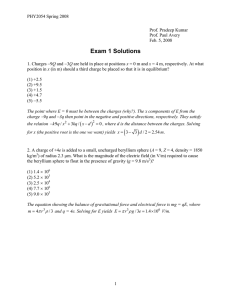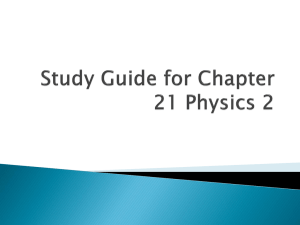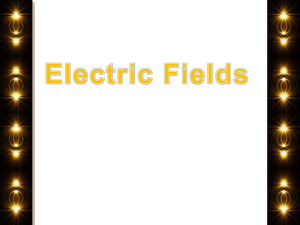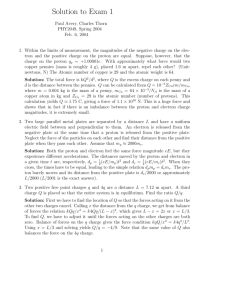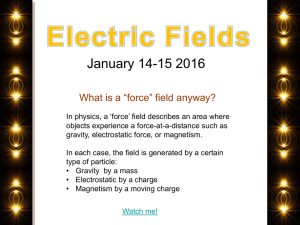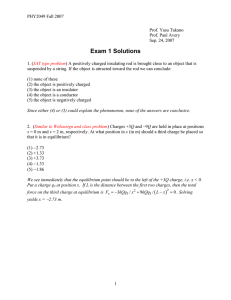Exam 1 Solutions
advertisement
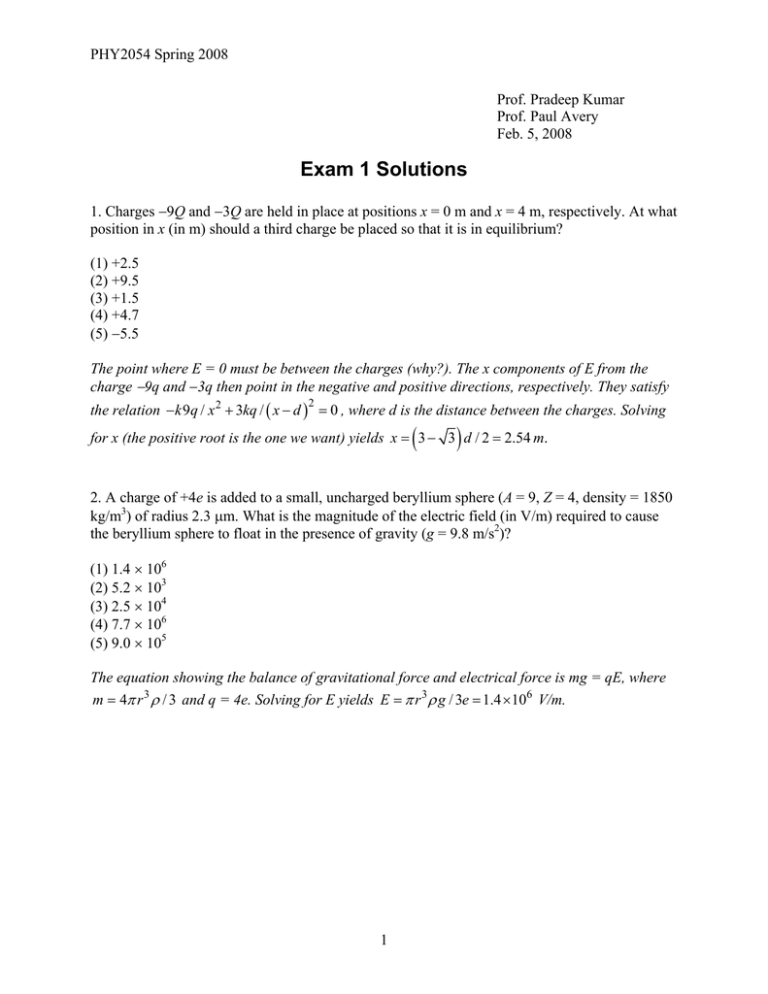
PHY2054 Spring 2008 Prof. Pradeep Kumar Prof. Paul Avery Feb. 5, 2008 Exam 1 Solutions 1. Charges −9Q and −3Q are held in place at positions x = 0 m and x = 4 m, respectively. At what position in x (in m) should a third charge be placed so that it is in equilibrium? (1) +2.5 (2) +9.5 (3) +1.5 (4) +4.7 (5) −5.5 The point where E = 0 must be between the charges (why?). The x components of E from the charge −9q and −3q then point in the negative and positive directions, respectively. They satisfy the relation − k 9q / x 2 + 3kq / ( x − d ) = 0 , where d is the distance between the charges. Solving 2 ( ) for x (the positive root is the one we want) yields x = 3 − 3 d / 2 = 2.54 m. 2. A charge of +4e is added to a small, uncharged beryllium sphere (A = 9, Z = 4, density = 1850 kg/m3) of radius 2.3 μm. What is the magnitude of the electric field (in V/m) required to cause the beryllium sphere to float in the presence of gravity (g = 9.8 m/s2)? (1) 1.4 × 106 (2) 5.2 × 103 (3) 2.5 × 104 (4) 7.7 × 106 (5) 9.0 × 105 The equation showing the balance of gravitational force and electrical force is mg = qE, where m = 4π r 3 ρ / 3 and q = 4e. Solving for E yields E = π r 3 ρ g / 3e = 1.4 ×106 V/m. 1 PHY2054 Spring 2008 3. Refer to the previous problem. How much positive charge (in coulombs) is carried by the protons in 0.34 gram of beryllium? (1) 14,600 (2) 3,600 (3) 130,000 (4) 390 (5) None of these The number of atoms in a mass m is given by mN 0 / A , where N0 is Avogadro’s number, and m and A are expressed in grams. The total charge Q is therefore Q = mN 0 Ze / A = 14, 600 C. 4. An electron moving horizontally at a velocity of 2.3 × 107 m/s enters a region with an electric field of magnitude E = 52,600 V/m in the same direction. How far in meters will the electron travel before it turns around? (1) 0.029 (2) 2.8 (3) 0.78 (4) 14 (5) 53 For constant acceleration, the velocity equation is v02 = 2ad , where v0 is the initial velocity, d is the distance to stop it and a = eE/me is the acceleration of the electron. Using v0 = 2.3 × 107 m/s yields d = me v02 / 2eE = 0.029 m. 5. Charges are arranged on a square of side d as shown in the diagram. In what direction is the electric field at the center of the square? (1) Fourth quadrant (2) First quadrant (3) Second quadrant (4) Third quadrant (5) E = 0 The fields from the corner charges all cancel on opposite ends. The E field from +Q and –Q points downward and the E field from +Q and –2Q points rightward. The net E field is thus negative in y and positive in x, so it is in the fourth quadrant. 2 PHY2054 Spring 2008 6. Refer to the previous problem. What is the potential at the center of the square (in units of kQ/d), assuming V = 0 at infinity? (1) −7.7 (2) +1.3 (3) −9.5 (4) −0.50 (5) +0 ( ) ( ) The total potential is −4kQ / d / 2 − kQ / ( d / 2 ) = − 4 2 + 2 kQ / d , where the first term comes from the corner charges and the second term comes from the left and right charges. Evaluating yields −7.7kQ/d. 7. A solid conducting sphere of radius 2.50 cm has a charge +5.30nC. A conducting spherical shell of inner radius 3.20 cm and outer radius 5.50 cm is concentric with the solid sphere and has a charge −3.10 nC. What is the magnitude of the electric field (in V/m) at a point 3.5 cm from the center of this charge configuration? (1) 0 (2) 39,000 (3) 16,000 (4) 23,000 (5) 77,000 The point is inside the conducting shell so the E field is zero. 8. In the accompanying figure are shown two charges at two corners of a triangle with two equal sides. If L = 2 m and Q = 4 nC, what is the magnitude of the electric field (in V/m) at the point X? (1) 9.8 (2) 2,300 (3) 47,000 (4) 460 (5) 87 The field from the charge on the left is E x = kQ / L2 , E y = 0 . The field from the charge on top ( ) ( has components E x = + kQ / 4 L2 (1/ 4 ) , E y = − kQ / 4 L2 ( E = kQ / 4 L2 ) 304 /16 = 9.8 V/m. 3 ) 15 /16 . The total field is thus PHY2054 Spring 2008 9. Consider a thin charged conducting circular disk of radius 4 cm. An E field of magnitude 400,000 V/m is measured just above the surface at the center of the disk. What is the total charge on the upper surface of the disk in nC? (1) 18 (2) 2.9 (3) 0.0045 (4) 0.071 (5) 240 The E field just above the surface of a conducting disk is E = σ / ε 0 , where σ = Q / π r 2 . Solving for Q yields Q = 17.8 nC. 10. Two protons are held at rest a distance of 1fm = 10−15 m apart. What is the speed of one of the protons (in m/s) a long time after they are released? (1) 1.2 × 107 (2) 5.2 × 106 (3) 4.9 × 105 (4) 1.7 × 104 (5) 9.2 × 103 Conservation of energy yields ke 2 / d = 12 m p v 2 + 12 m p v 2 = m p v 2 , where the velocities of the protons have to be identical. Solving for v yields v = 1.2× 107m/s. 11. The equipotential surfaces associated with an isolated point charge: (1) are concentric spheres centered at the charge (2) point radially outward from the charge (3) are vertical planes (4) have a shape depending on the magnitude of the point charge (5) are concentric cylinders with the charge on the axis We discussed this in class. Each surface of constant potential is at the same distance from the point, making a spherical surface. 4 PHY2054 Spring 2008 12. Seven identical capacitors are arranged as in the figure. What is the equivalent capacitance (in μF) between points a and b if capacitance C = 10 μF? (1) 4.3 (2) 15.0 (3) 16.7 (4) 6.0 (5) None of these This figure is equivalent two 3 groups of capacitors in series, C, 3C/2 and 3C/2, yielding 3C/7. 13. In the accompanying figure, C1 = 25 μF, C2 = 20 μF, C3 = 10 μF, and ΔV0 = 21 V. Determine the charge (in μC) stored by C2. (1) 190 (2) 0.13 (3) 25 (4) 57 (5) 8.9 First, we determine the equivalent capacitance, which is Ceq = 25 × 30 / (25 + 30) = 13.64 μF. The total charge is then qtot = 13.64 × 21 = 286.4 μC. This is also the charge on C1, so the voltage on C1 is V1 = qtot / C1 = 11.45 V. The voltage across C2 is V2 = 21 – 11.45 = 9.55 V. Thus the charge on C2 is q2 = C2V2 = 20 × 9.55 = 191 μC. 14. A special room is set up at NASA with a downward pointing electric field of magnitude E = 23,000V/m. A charged ball of mass 2.1 kg and charge −150 μC is shot vertically from the floor at 15 m/s. Assuming the electric potential at the floor is zero, what is the maximum potential (in kvolts) that the ball reaches? g = 9.8 m/s2 (1) 410 (2) 200 (3) 260 (4) 140 (5) 320 The total force on the ball is mg + qE, thus the total acceleration is a = g + qE/m. The maximum height reached is h = v2 / 2a and thus the maximum potential reached is Eh = Ev2 / 2(g+qE/m) = 317 kV. 5 PHY2054 Spring 2008 15. The potential difference between a pair of oppositely charged parallel plates is 450V when the plate separation is 1 μm. If the spacing between the plates is tripled without altering the charge on the plates, what is the new potential difference (in volts) between the plates? (1) 1350 (2) 150 (3) 50 (4) 450 (5) 4050 Since the charge is unchanged, the E field is unchanged. Using V = Ed, the voltage is tripled to 1350 V. 16. Refer to the previous problem. If the plate separation is doubled to 2 μm while the potential difference between the plates is kept constant, what is the ratio of the final charge on one of the plates to the original charge? (1) 1 / 2 (2) 1 / 4 (3) 2 (4) 4 (5) 3 If the plate separation is doubled, the capacitance is halved. Thus if the voltage is unchanged, then by Q = CV the charge on the plates is halved. 17. Refer to the previous problem with the capacitor having its original plate separation of 1 μm. After being charged to a potential of 120V, the capacitor is disconnected from the circuit and has a slab of dielectric (κ = 2.7) carefully inserted between the plates without touching them. The new potential difference is (1) None of these (2) 320 (3) 120 (4) 0 (5) 60 The charge is unchanged. Placing a dielectric inside has the effect of reducing the voltage by κ. Thus the new voltage is 120 / 2.7 = 44.4 V. 6 PHY2054 Spring 2008 18. A flashlight bulb operating at a voltage of 4.5 V has a resistance of 8.0 Ω. How many electrons pass through the bulb filament per second? (1) 3.5 × 1018 (2) 1.8 × 1021 (3) 1.1 × 1019 (4) 3.7 × 1016 (5) none of these The current is 4.5 /8.0 = 0.56 A. So in 1.0 second, the number of electrons is 0.56 / 1.6 × 10−19 = 3.5 × 1018. 19. A large magnet is constructed by winding a very long aluminum wire of rectangular cross section (3 mm × 3 mm) around a cylindrical spool. If the wire carries a current of 13,000 A, what is the drift speed of the electrons (in m/s) in the wire assuming that there is one conduction electron per atom? Aluminum has a density of 2700 kg/m3, an atomic number of 13 and an atomic mass of 27.0. (1) 0.15 (2) 0.00028 (3) 0.0042 (4) 0.038 (5) 0.097 The formula relating current to electron drift velocity is i = neAcevd, where Ac = 9 × 10−6 m2 is the cross sectional area, e is the electron charge and vd is the drift velocity. The number density ne is the same as the number density of Aluminum atoms, assuming 1 drift electron per atom. The number density is obtained by dividing the density by the mass of each atom, or ne = ρ / (0.001A/NA) = 6.0 × 1028 / m3 where A = 27 is the atomic mass and NA is Avogadro’s number (the 0.001 converts grams to kg). Solving for vd yields vd = 0.15 m/s. 20. In the Bohr model of the hydrogen atom, an electron in the 7th excited state moves at a speed of 4.47 × 104 m/s in a circular path having a radius of 2.59 × 10−9 m. What is the effective current (in amps) associated with this orbiting electron? (1) 4.4 × 10−7 (2) 2.8 × 10−6 (3) 7.6 × 10−5 (4) 5.9 × 10−8 (5) 4.9 × 10−8 The current is given by e / T, where T = 2πr / v. This yields i = ev / 2πr = 4.4 × 10−7 A. 7
